Table of Contents
Carpal tunnel release is a surgical procedure to treat carpal tunnel syndrome (CTS). It’s been proven to be an effective treatment for CTS – here are some of the stats:
- 90% of patients who had carpal tunnel release surgery are happy that they had the surgery.
- 70-90% of people had a good or excellent outcome after CTS surgery.
- 90% see a reduction in symptoms, where 80% see an improvement in hand function.
- Following surgery, there is a 5-10% chance of recurrence.
In this article, we’ll go through how the procedure is performed, the pros and cons, and the risks involved.
Book a Consultation with Dr. Pamela Mehta, MD
The Best Orthopedic Surgeon in San Jose
Dr. Mehta is a board-certified orthopedic surgeon who can help you recover from your joint condition. If you:
- Are Suffering From Pain and Mobility Issues
- Need Orthopedic Assessment and Advice
- Want Treatment From a Top Orthopedic Doctor
We Can Help
About Carpal Tunnel Surgery
The main goal of carpal tunnel release is to alleviate pressure on your median nerve.
To make that happen, the surgeon cuts the transverse carpal ligament. This ligament runs lengthwise across the roof of the carpal tunnel.
Cutting the ligament reduces the pressure on the median nerve.
Carpal tunnel release allows for more room within the carpal tunnel. In turn, it reduces symptoms such as:
- Hand pain
- Numbness
- Tingling
- Weakness in your hand and fingers
Most importantly, carpal tunnel release can improve your quality of life.
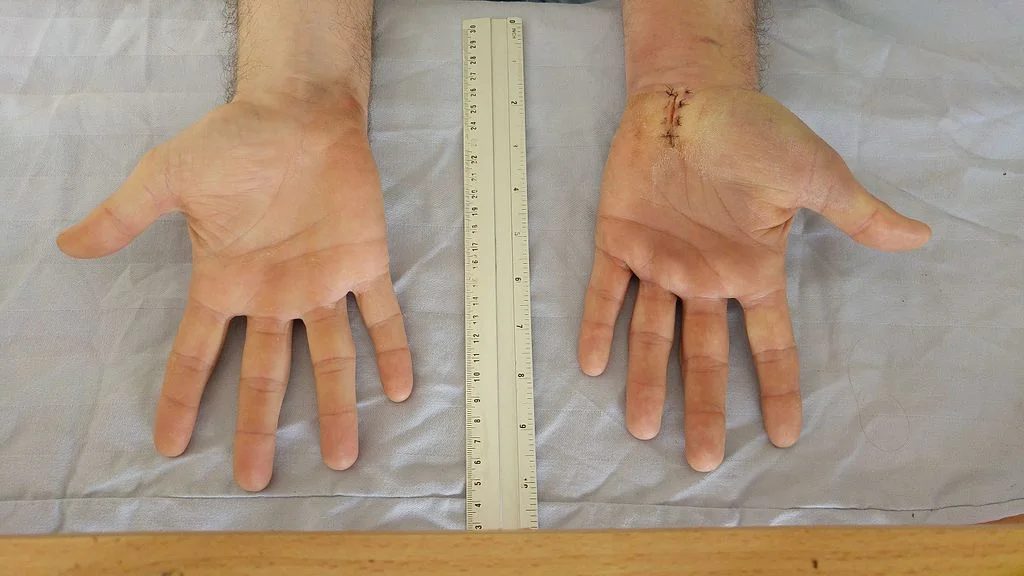
Indications
Carpal tunnel release is necessary in some cases, including:
- When the symptoms of carpal tunnel syndrome are severe
- When symptoms are mild but unresponsive to non-surgical treatment
- If symptoms have lasted at least six months without relief
- When the muscles in the hand and wrist are weak and getting smaller
To decide whether your carpal tunnel syndrome symptoms need surgery, get in touch with a hand surgeon near you.
Anesthesia for Carpal Tunnel release
Carpal tunnel surgery anesthesia depends on the type of surgery being performed. Generally, we try to make you comfortable using the least invasive option.
The main options for anesthesia during carpal tunnel release include:
Local anesthesia. This involves administering an injection to numb the area where the surgery is performed. This type of anesthesia doesn’t put you asleep, so you’re awake during the procedure.
Regional anesthesia. Medicines used in the method above are applied differently during regional anesthesia. To create a numb area, we block the action of the nerve that supplies feelings to the area we are operating on. In this case, we can use techniques such as wrist blocks. It is a safe, effective, and time-saving approach for anesthesia in carpal tunnel release.
General anesthesia. Using this method, we send you to sleep so you’re unconscious for the duration of the procedure. General anesthesia comes with more risks but might be necessary for more complicated procedures.
Who Performs Carpal Tunnel Surgery?
While this might sound like a strange question being posted on an orthopedic website, there are actually a few different types of specialists that perform CTS release!
Typically, carpal tunnel surgery is performed by hand surgeons. These are orthopedic surgeons who have specialized in hand surgery. Hand surgeons operate on the hand, wrist, and forearm.
However, most orthopedic surgeons will have experience in performing this procedure. Orthopedic surgeon is a type of surgeon who is trained to treat or diagnose problems affecting the bones, joints, and muscles.
Besides orthopedic and hand surgeons, other specialists who perform carpal tunnel release are:
- Neurosurgeon: specializes in surgical interventions of the nervous system, including brain, spinal cord, and peripheral nerves.
- Plastic surgeon: trained to perform reconstructive procedures.

Can I Get Carpal Tunnel Surgery in Both Hands?
Yes, you can get carpal tunnel surgery in both hands at the same time.
Many people experience symptoms of carpal tunnel syndrome in both hands. If you’re one of them, it may seem more practical to get surgery in both hands at once.
Carpal tunnel surgery in both hands usually involves general anesthesia, as this is a more complex procedure. The surgeon performs the surgery on both hands separately. This approach allows for a single period of surgical care and rehabilitation.
However, most patients prefer to tackle symptoms of carpal tunnel syndrome in one hand at a time. We would usually advise treating the hand with more severe symptoms first. This way, you can assess the results of the procedure before deciding to have another.
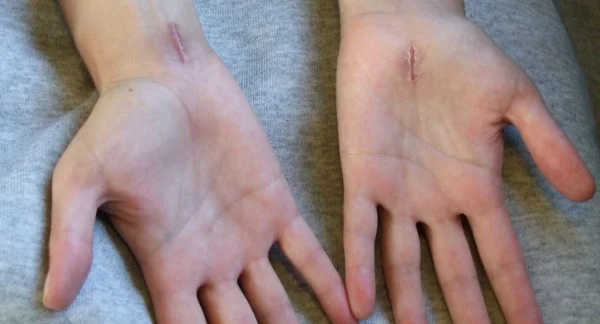
Preparing for Surgery
In order to prepare for surgery, you should do the following:
- Inform your doctor about medications you’re taking (including over-the-counter drugs and dietary supplements)
- Consider quitting smoking to improve chances of successful wound healing
- Refrain from eating or drinking anything 6-12 hours before the procedure
- Arrange for someone to pick you up after surgery
- Prepare your home by getting necessities such as groceries, pain medication, and ice packs
- Prepare your documents to bring with you on the day of surgery (driver’s license, insurance card)
- Wear comfortable or loose-fitting clothes that are easy to put on and take off
In the next section, we’ll go over the types of carpal tunnel surgery and the recovery period, so you know what to expect.
Pictures of the Hand After Carpal Tunnel Surgery
Here is the progress that you could experience following carpal tunnel surgery. These images come from a patient of Dr. Mehta, who has kindly agreed to share his recovery journey with you!
If you want to see if you can get similar results, get in touch to book a consultation.
Weeks After Surgery
In the first few days after surgery, you’ll have sutures on the surgical wound. Here is a picture of immediately post-procedure, and a week or two later.
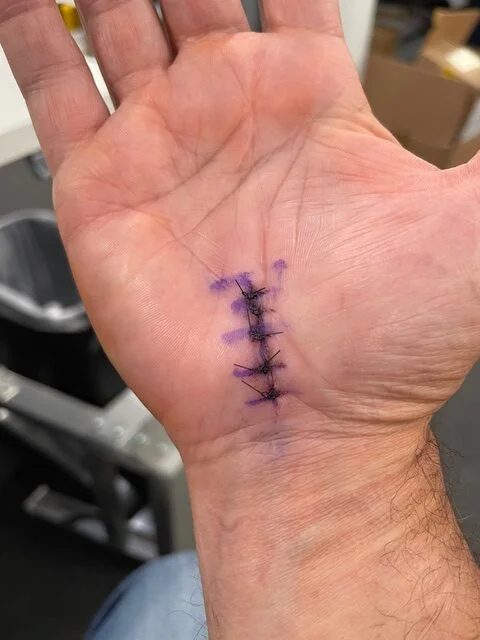
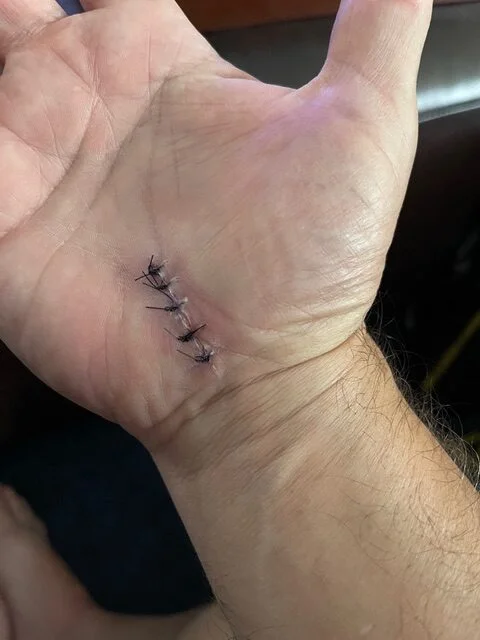
Healing in Progress
If your sutures aren’t dissolvable, they will be taken out in the first couple of weeks. You will be able to see a small scar on your hand, which heals over time.
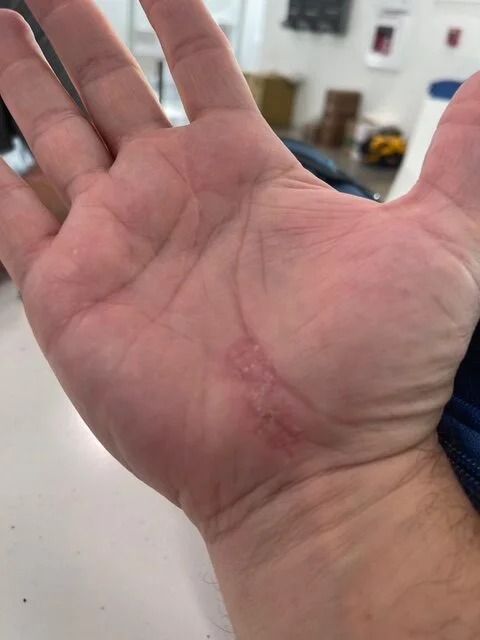
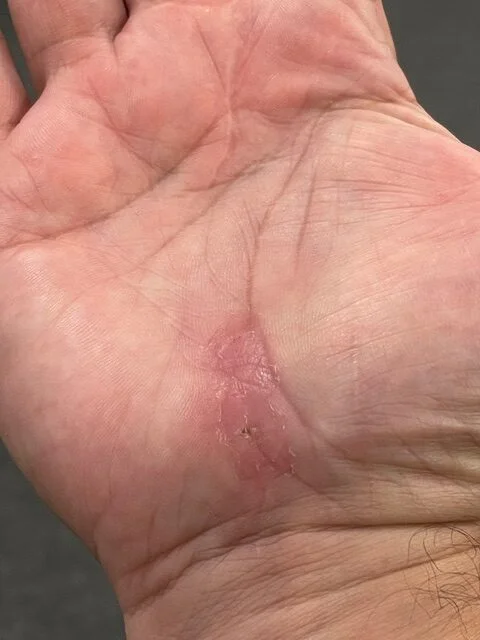
Completely Healed
If you find a skilled surgeon such as Dr. Mehta, your scar may be completely unnoticeable after healing!
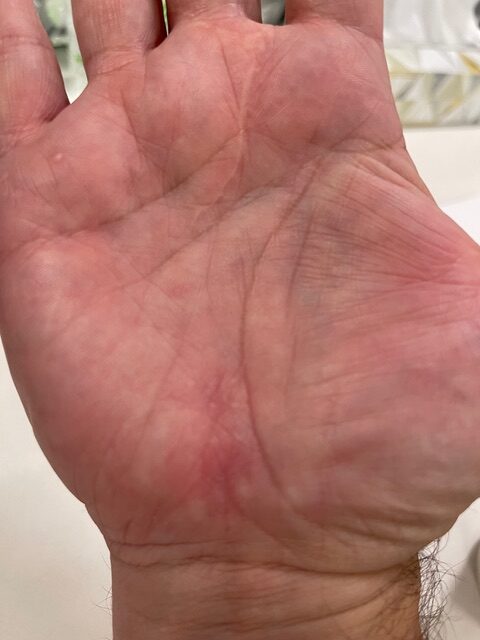
Types of Carpal Tunnel Surgery
Open Carpal Tunnel Release
Open carpal tunnel release is a traditional method of carpal tunnel surgery. During the procedure, the surgeon cuts open the wrist with a two-inch incision. With conventional surgical instruments, the surgeon severs the carpal tunnel ligament. This enlarges the carpal tunnel.
Open surgery is a safe procedure. It allows the surgeon to have direct vision of the ligament, helping them to avoid damaging adjacent structures.
However, open surgery is associated with a relatively large surgical scar and increased pain. Your surgeon will counsel you on whether it is worth taking the risks, and what the most appropriate option is.
Ultrasound Guided Carpal Tunnel Release
Ultrasound-guided carpal tunnel release is also a minimally invasive procedure. In this case, the surgeon relies on ultrasound imaging to guide the release of the carpal ligament.
The surgery requires local anesthesia. Only a small amount of numbing medicine on the palm is necessary. This means that you’ll be awake during the procedure, but you won’t be able to feel pain.
Benefits of this procedure include:
- Tiny incisions (less than 5mm)
- Fast recovery
- Precise visualization
- Quickly improves hand function
- Reduces hand discomfort
- Safe and effective alternative to traditional surgery
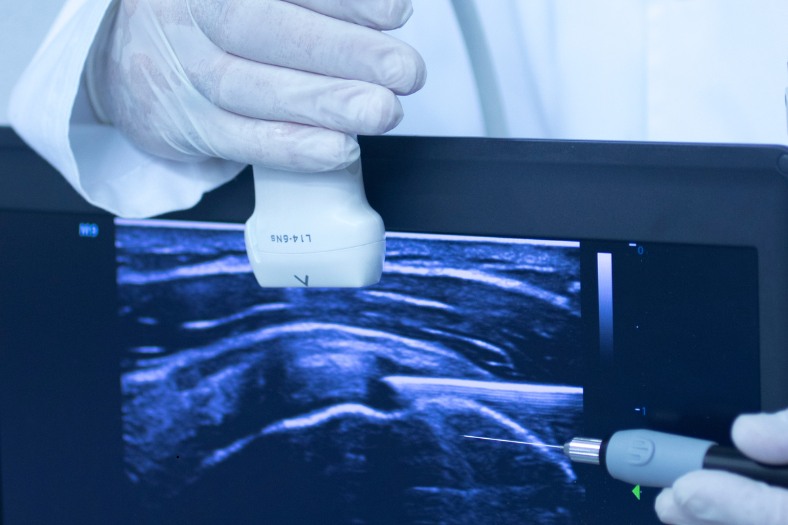
Pros and Cons of Carpal Tunnel Surgery
Every surgery has its advantages and disadvantages. When we recommend a procedure or treatment, we think the benefits are greater than the risks. However, it’s important to discuss the various options and alternatives with your hand surgeon to see which fits best with your circumstances.
Here are the pros and cons of carpal tunnel surgery.
Pros:
- The procedure has a high success rate
- The surgery is quick (15-30 minutes)
- Recovery from the procedure is relatively fast
- You should feel relief from the numbing and pain in your hand
- It’s likely to improve your hand function, grip strength, and mobility
Cons:
- The procedure may cause infection or buildup of scar tissue
- There is a small risk of nerve damage
- The cost of carpal tunnel surgery is higher than the alternatives
- Swelling after the procedure may cause new or worsen current symptoms temporarily
- Symptoms of carpal tunnel syndrome may return
Choose a hand surgeon wisely to avoid complications and recurrence of carpal tunnel.
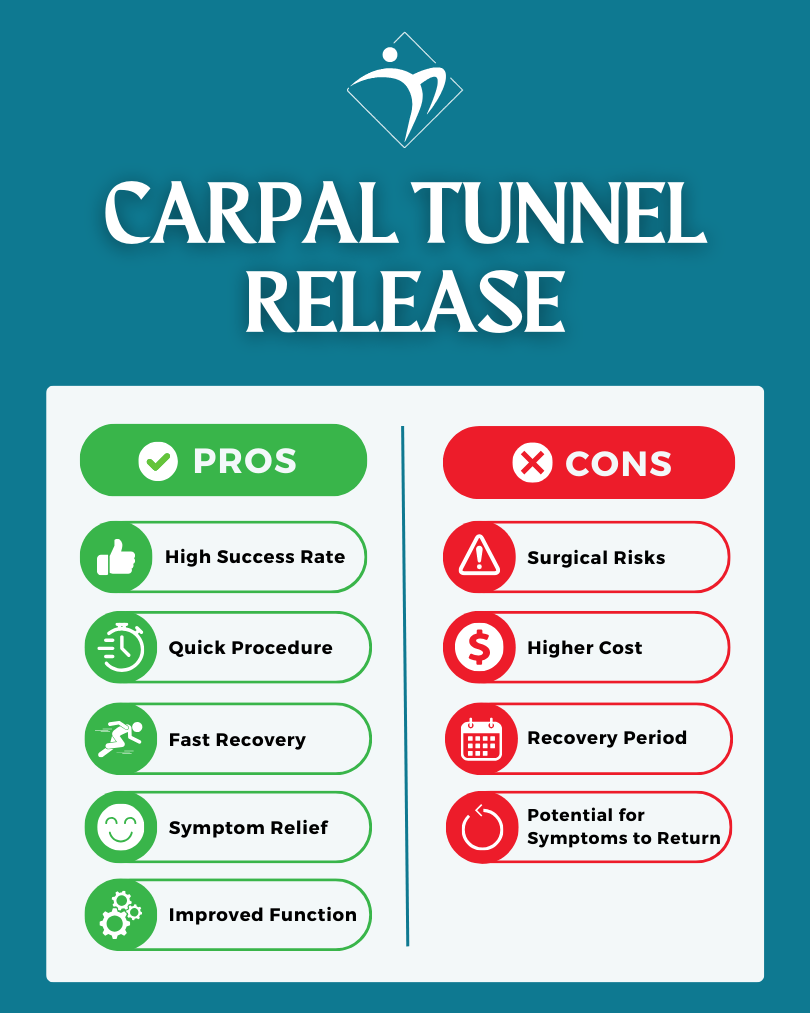
Carpal Tunnel Injection vs Surgery
One alternative treatment for carpal tunnel surgery is an injection. This can take the form of a steroid or regenerative treatment.
An injection is obviously a less intensive procedure, and may be more appropriate for those who have mild-moderate symptoms. However, for those with severe symptoms or that have had an injection without significant improvement, surgery may be the better option.
Here are the main differences:
- An injection is less invasive and carries less risk
- The benefits of an injection are more temporary
- An injection is required more often to maintain benefits
- Surgery leads to long-term improvement in carpal tunnel symptoms
- Surgery involves a recovery process (it’s short, but longer than injection)
While injection produces short-term relief, surgery is necessary for long-term symptom reduction.
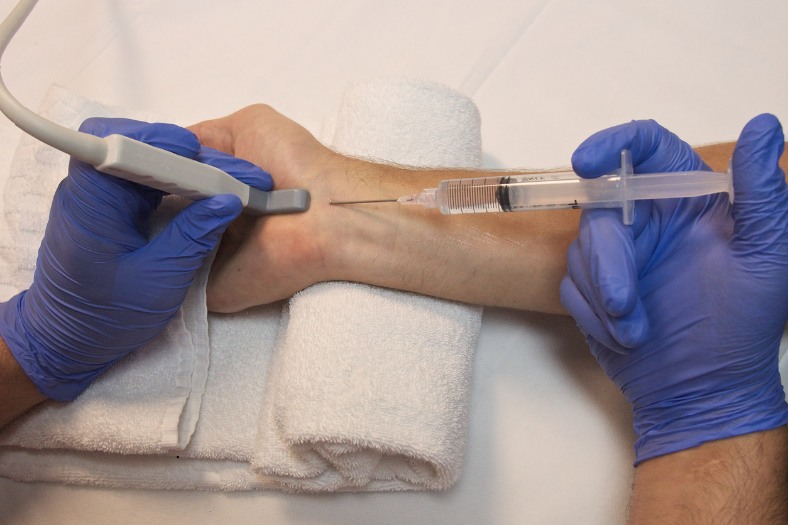
Potential Risks and Complications
Every surgery and procedure carries risks, which your surgeon will carefully consider. If they feel that the benefits outweigh the risks, they will still reccomend having carpal tunnel surgery. However, you should be aware of the risks.
The overall risk of a “serious complication” (requiring hospital admission or corrective surgery) is less than 0.1% (fewer than 1 in 1000 patients). The chance of more minor complications (pain, scarring, infection) is around 10% (1 in 10).
Scarring
Excessive buildup of scar tissue is a common problem after carpal tunnel release. Your body tries to heal the area and produces new cells excessively. This leads to the formation of scar tissue.
Scar tissue may prevent the median nerve and tendons from gliding smoothly into the carpal tunnel. This can lead to pain and decreased range of motion, which might require further surgery.
Carpal tunnel surgery scar is generally sore for a few weeks after the procedure. Once it settles, the scar isn’t visible. Formation of scar tissue is more common in open surgery.
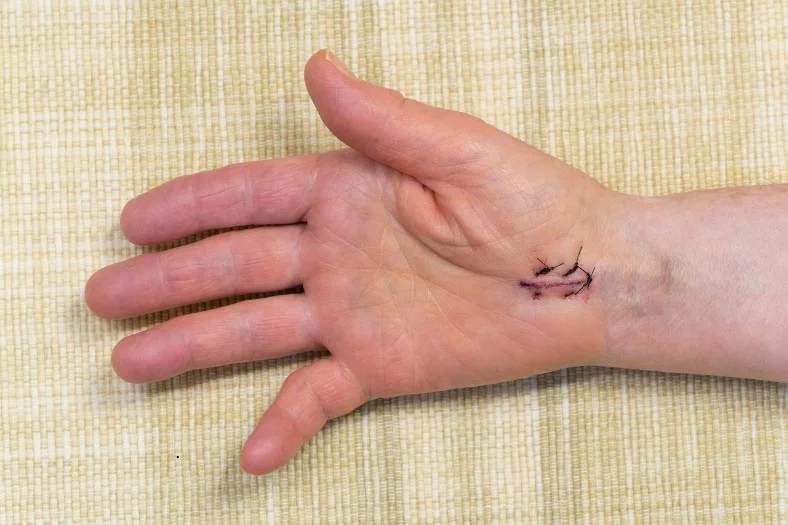
Pain
Pain after surgery is normal. Pain and discomfort at the incision site are usually short-term. The stabbing pain after carpal tunnel surgery results from the healing process of the median nerve. Pain resolves within a few weeks.
Long-term pain is also possible. “Pillar pain” is a type of pain that occurs after CTS surgery, and may last at least three months. It affects the base of your hand in the base of your palm. Consult your surgeon if the pain doesn’t go away.
Bruising & Swelling
Bruising after carpal tunnel release surgery is to be expected. You may also notice swelling at the surgical site. Bruising and swelling result from manipulation of tissues during the surgery.
These side effects usually settle without any treatment. Apply cold packs to alleviate discomfort. It’s also useful to keep your hand elevated above the level of the heart if you experience bruising after carpal tunnel surgery.
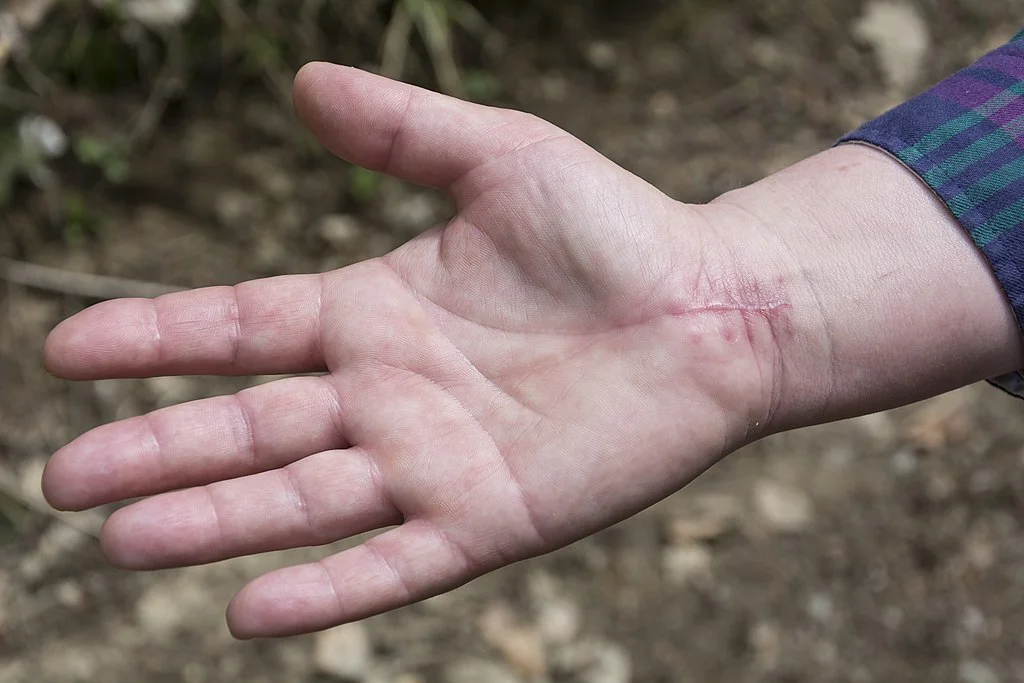
Infection
One of the biggest complications of carpal tunnel surgery is infection. Signs of infection after carpal tunnel surgery include:
- Fever & cold sweats
- Increased pain and swelling
- Warmth and redness in your wrist
- Pus draining from the incision
- Red streaks leading from the incision
Infection can be easy to deal with but needs prompt treatment. Seek medical attention immediately if these symptoms appear.
Nerve damage
Nerve damage is a rare complication of carpal tunnel surgery.
Open surgery may lead to ulnar nerve injury. Ulnar nerve damage after carpal tunnel surgery occurs due to the nerve’s anatomical proximity to the median nerve.
Symptoms of nerve damage include worsening pain, tingling, weakness, and numbness.
Ready to Recover?
Take the first step in getting back to your normal self, and book an appointment with Dr. Mehta today.
We’re ready when you are!
Other
Carpal tunnel release may cause several complications. These include:
- Bleeding
- Injuries to nearby blood vessels
- Stiffness in your hand
- A weaker grip

How Long is Recovery from Carpal Tunnel Surgery?
Recovery from carpal tunnel surgery can vary depending on several factors, including:
- The Type of Surgery. Minimally invasive procedures often have a slightly quicker recovery time compared to open surgery. This includes endoscopic surgery and ultrasound-guided carpal tunnel release.
- The severity of Carpal Tunnel Syndrome Symptoms. More severe cases might have a longer recovery period, as the procedure will be trickier.
- Post-Surgical Care. The quality of your post-procedure care is significant. Take care to follow your surgeons instructions on physical therapy, wound care, and follow-up appointments.
- Individual Health Factors. Age, overall health, and pre-existing conditions can affect how quickly you recover. For example, if you are over 80, or suffer from a condition such as diabetes, wound healing takes more time.
The skill and experience of your doctor also matters. For a smooth experience, get in touch with us at Resilience Orthopedics to see how we can help.
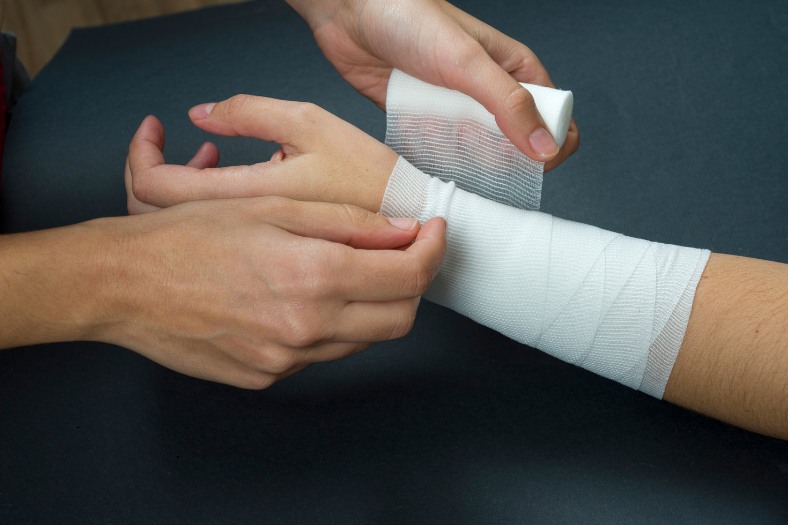
Here’s a run-down of the recovery period:
Immediately After Surgery
First Few Days:
Pain, swelling, and stiffness are common after carpal tunnel surgery. You may also experience some numbness in your hand.
Your hand and wrist may be bandaged or placed in a splint for the first few days. Your surgeon will prescribe painkillers and give you advice on how to improve post-op symptoms.
1-2 Weeks:
Sutures are usually removed if non-dissolvable ones were used.
Pain and swelling should improve, though you will still feel quite stiff. There is a chance that you might start to feel “pillar pain” in the base of your hand.
You might start light physical therapy, including finger exercises, at this point.
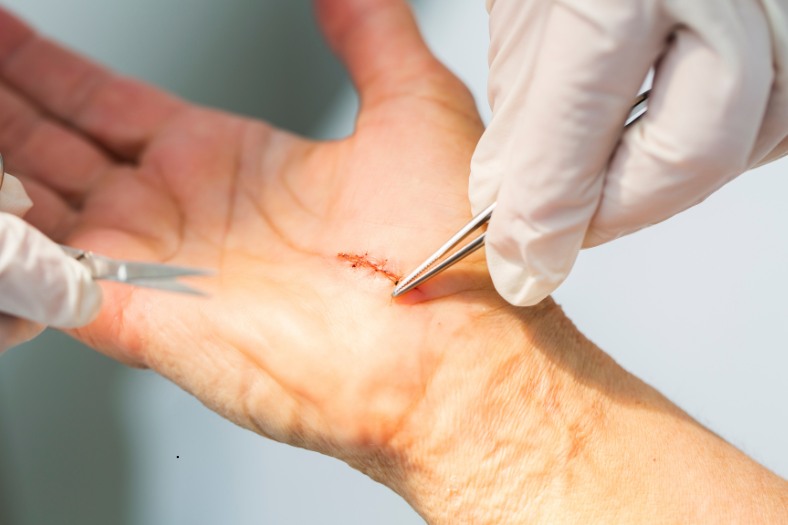
Short-Term Recovery
2-4 Weeks:
Many people can return to light activities and work that does not strain the wrist. Make sure you check with your doctor to ensure you don’t do lasting damage or prevent healing.
Physical therapy may start to help restore movement and strength in your hand and wrist.
4-6 Weeks:
After 4 weeks you should see more significant improvement in hand function. Swelling in your hand will continue to improve, though may still be present near the surgical site.
You will be able to gradually return to regular activities, but heavy lifting and strenuous activities are still not advised.

Long-Term Recovery
6-12 Weeks:
Most people will regain full hand and wrist function at this stage. If you work in a job that isn’t too physically demanding, you should be able to return to work.
Residual symptoms like mild discomfort or stiffness may persist but should gradually improve. If you experienced “pillar pain” in your hand, it should improve by the end of 12 weeks.
3-6 Months:
After 3-6 months you should experience a complete recovery, unless you had any complications. You should be able to return to physically demanding jobs and activities.
Any lingering symptoms are generally mild and infrequent. Maximum hand strength may take up to a year to recover. Make sure you’re still doing the exercises encouraged by your surgeon to make a complete recovery.

Frequently Asked Questions
Why is my hand cold after carpal tunnel surgery?
If you’re wondering why your hand is cold after carpal tunnel surgery, the explanation is simple – it occurs due to a temporary disruption in blood flow.
Both injury and surgery on the nerves can lead to a cold sensation in your hand. The procedure may temporarily affect nerve function. That’s another reason for cold hands.
If the problem persists, you may want to contact your surgeon.
When is carpal tunnel syndrome bad enough for surgery?
This depends entirely on your personal circumstances. If you work in a manual job, even mild symptoms might be interfering with your work, and so surgery might be advised.
If you are only experiencing mild-moderate symptoms with limited impact on your life, your surgeon will discuss alternatives with you first.
Severe symptoms such as constant pain, consistent numbness, and muscle weakness are signs that your CTS is bad enough to require surgery.
How long after carpal tunnel surgery can I drive?
This depends on which hand has been operated on. If your non-dominant hand was operated on, you may feel able to control your car after 2-4 weeks. However, if it was your dominant hand, it might take more like 4-6 weeks.
We would reccomend that you regain hand strength and feeling before driving. If you’re still weak in your hand and wrist, it might increase the likelihood of an accident.
You should also consider your car insurance. Some companies will refuse to insure drivers until a full recovery has been made. Talk to your insurance company and your surgeon before making the decision to start driving again.
How much does carpal tunnel surgery cost?
The cost of carpal tunnel surgery in the United States can vary widely depending on the type of surgery, the facility where the surgery is performed, where you live, and if you have insurance.
However, this isn’t a case where you should go for the cheapest option. By choosing a surgeon with experience and a good post-operative care plan, you can feel confident that you’ve done everything possible to reduce the risk of complications.
If you’re based in San Jose, call us at (408) 559-3888 for an estimate based on your circumstances.
How many times can you have carpal tunnel surgery?
Technically, you can have carpal tunnel surgery as many times as you need. If your first procedure goes well, you should only need it once. If you have any complications or the symptoms recur, you may require a second procedure.
However, the more times you have the procedure, the bigger the risk of complications and scar tissue.
Do you need physical therapy after carpal tunnel surgery?
You should absolutely take part in physical therapy, or exercises directed by your surgeon, after carpal tunnel surgery.
In the recovery process, you will start with very light finger exercises, gradually moving on to grip-strength and mobility exercises by week 6.
Your surgeon will give you an exercise and PT programme to follow after the procedure.




